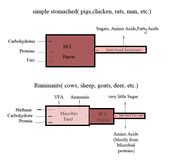Ruminant
| Ruminants | |
|---|---|
.png) |
|
| Rough illustration of a ruminant digestive system | |
| Scientific classification | |
| Kingdom: | Animalia |
| Phylum: | Chordata |
| Class: | Mammalia |
| Order: | Artiodactyla |
| Suborder: | Ruminantia |
| Families | |
|
Antilocapridae |
|
Physiologically, a ruminant is a mammal of the order Artiodactyla that digests plant-based food by initially softening it within the animal's first stomach, then regurgitating the semi-digested mass, now known as cud, and chewing it again. The process of rechewing the cud to further break down plant matter and stimulate digestion is called "ruminating". Ruminating mammals include cattle, goats, sheep, giraffes, bison, yaks, water buffalo, deer, camels, alpacas, llamas, wildebeest, antelope, pronghorn, and nilgai. Taxonomically, the suborder Ruminantia includes all those species except the camels, llamas, and alpacas, which are Tylopoda. Therefore, the term 'ruminant' is not synonymous with Ruminantia. The word "ruminant" comes from the Latin ruminare, which means "to chew over again".
Contents |
Explanation

In the first two chambers, the rumen and the reticulum, the food is mixed with saliva and separates into layers of solid and liquid material. Solids clump together to form the cud or bolus). The cud is then regurgitated, chewed slowly to completely mix it with saliva and to break down the particle size. Fiber, especially cellulose and hemi-cellulose, is primarily broken down into the three volatile fatty acids, acetic acid, propionic acid and butyric acid, in these chambers by microbes (bacteria, protozoa, and fungi). Protein and non-structural carbohydrate (pectin, sugars, starches) are also fermented.
Even though the rumen and reticulum have different names they represent the same functional space as digesta can move back and forth between them. Together these chambers are called the reticulorumen. The degraded digesta, which is now in the lower liquid part of the reticulorumen, then passes into the next chamber, the omasum, where water and many of the inorganic mineral elements are absorbed into the blood stream. After this the digesta is moved to the true stomach, the abomasum. The abomasum is the direct equivalent of the monogastric stomach (for example that of the human or pig), and digesta is digested here in much the same way. Digesta is finally moved into the small intestine, where the digestion and absorption of nutrients occurs. Microbes produced in the reticulorumen are also digested in the small intestine. Fermentation continues in the large intestine in the same way as in the reticulorumen.
Almost all the glucose produced by the breaking down of cellulose and hemi-cellulose is used by microbes in the rumen, and as such ruminants usually absorb little glucose from the small intestine. Rather, ruminants' requirement for glucose (for brain function and lactation if appropriate) is made by the liver from propionate, one of the volatile fatty acids made in the rumen.

Classification
Hofmann and Stewart divided ruminants into three major categories based on their feed type and feeding habits: concentrate selectors; intermediate types; and grass/roughage eaters, with the assumption that feeding habits in ruminants cause morphological differences in their digestive systems, including salivary glands, rumen size, and rumen papillae.[5][6]
Abundance and distribution
Wild ruminants number at least 75 million and are native to all continents except Australia and Antarctica. Nearly 90% of all species are found in Eurasia and Africa alone. Species inhabit a wide range of climates (from tropic to arctic) and habitats (from open plains to forests). The population of domestic ruminants is greater than 3.5 billion, with cattle, sheep, and goats accounting for about 95% of the total population. [7]
Religious importance
In Abrahamic religions, a distinction between clean and unclean animals approximately falls according to whether the animal ruminates. The Law of Moses in the Bible allowed only the eating of animals that had cloven hooves and "that chew the cud",[8] a stipulation preserved to this day in the Jewish laws of Kashrut.
In humans
Rumination in humans is not considered ordinary behavior. It can be the result of physical or mental trauma, and can become a chronic disorder known as rumination syndrome.
Other uses
The verb to ruminate has been extended metaphorically to mean to ponder thoughtfully or to meditate on some topic. Similarly, ideas may be chewed on or digested. Chew the (one's) cud is to reflect or meditate.
Ruminants and climate change
Methane production by animals may contribute to a greenhouse effect or climate change. Methane production by animals, principally ruminants, is estimated 15-20% global production of methane.[9] [10] The rumen is the major site of methane production in ruminants.[11] In Australia, methane production from ruminants some have estimated 99.8% of total methane production results from livestock.[12]
See also
- Monogastric
References
- ↑ Russell,J. B. 2002. Rumen Microbiology and its role In Ruminant Nutrition.
- ↑ William O. Reece. "Functional Anatomy and Physiology of Domestic Animals". http://books.google.com/books?id=gvt_qSsLobUC&pg=PA350&lpg=PA350&dq=tylopoda+omasum&source=bl.
- ↑ Esther J. Finegan and C. Edward Stevens. "Digestive System of Vertebrates". http://www.cnsweb.org/digestvertebrates/WWWEdStevensCDAnatomy.html.
- ↑ Muhammad Khalil. "The anatomy of the digestive system". http://www.onemedicine.tuskegee.edu/DigestiveSystem/Stomach/Stomach_Ruminants.html.
- ↑ Ditchkoff, S. S. 2000. "A decade since “diversification of ruminants”: has our knowledge improved?". Oecologia, 125:82-84
- ↑ Hofmann. R. R. 1989."Evolutionary steps of ecophysiological and diversification of ruminants :a comparative view of their digestive system". Oecologia, 78:443-457
- ↑ Hackmann. T. J., and Spain, J. N. 2010."Ruminant ecology and evolution: Perspectives useful to livestock research and production". Journal of Dairy Science, 93:1320-1334
- ↑ Leviticus 11:6
- ↑ Cicerone, R. J., and R. S. Oremland. 1988 "Biogeochemical Aspects of Atmospheric Methane"
- ↑ Yavitt, J. B. 1992. Methane, biogeochemical cycle. Pages 197–207 in Encyclopedia of Earth System Science, Vol. 3. Acad.Press, London, England.
- ↑ Asanuma. N., M. Iwamoto, T. Hino. 1999."Effect of the addition of fumarate on methane production by ruminal microorganisms in vitro." J. Dairy Sci.82:780–787
- ↑ Hegarty, R. "Greenhouse gas emissions from the Australian Livestock sector"
External links
- Digestive Physiology of Herbivores - Colorado State University